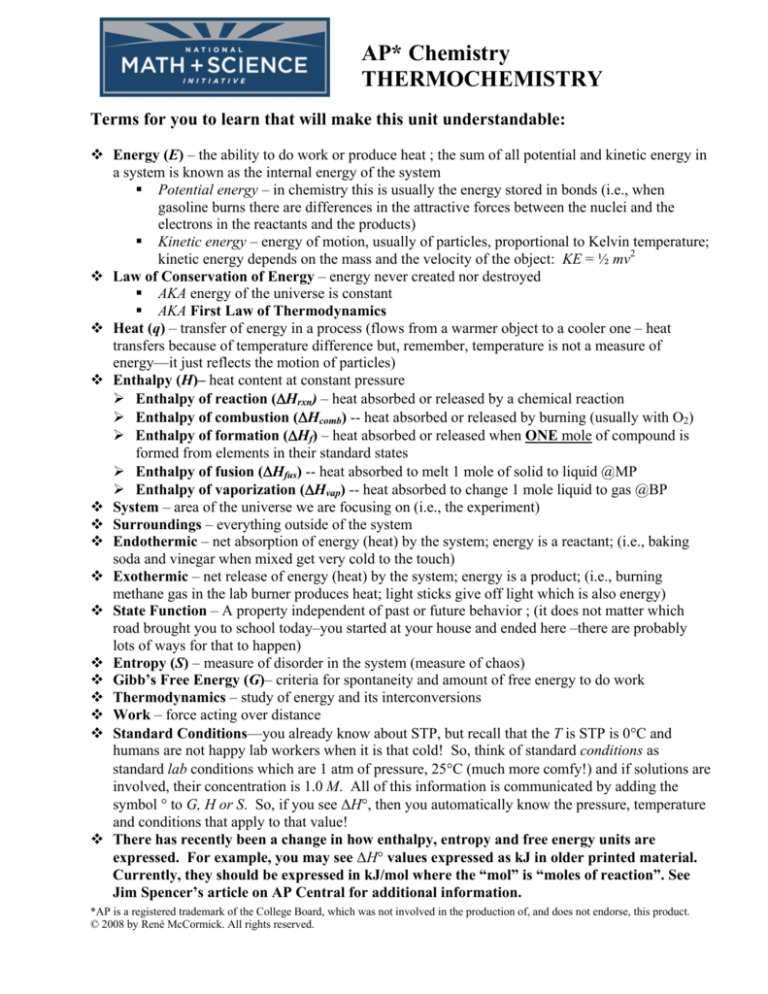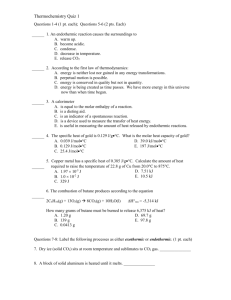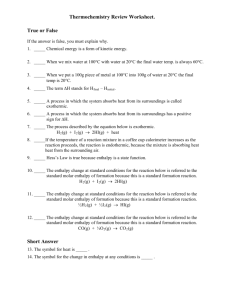
AP* Chemistry
THERMOCHEMISTRY
Terms for you to learn that will make this unit understandable:
Energy (E) – the ability to do work or produce heat ; the sum of all potential and kinetic energy in
a system is known as the internal energy of the system
Potential energy – in chemistry this is usually the energy stored in bonds (i.e., when
gasoline burns there are differences in the attractive forces between the nuclei and the
electrons in the reactants and the products)
Kinetic energy – energy of motion, usually of particles, proportional to Kelvin temperature;
kinetic energy depends on the mass and the velocity of the object: KE = ½ mv2
Law of Conservation of Energy – energy never created nor destroyed
AKA energy of the universe is constant
AKA First Law of Thermodynamics
Heat (q) – transfer of energy in a process (flows from a warmer object to a cooler one – heat
transfers because of temperature difference but, remember, temperature is not a measure of
energy—it just reflects the motion of particles)
Enthalpy (H)– heat content at constant pressure
¾ Enthalpy of reaction (ΔHrxn) – heat absorbed or released by a chemical reaction
¾ Enthalpy of combustion (ΔHcomb) -- heat absorbed or released by burning (usually with O2)
¾ Enthalpy of formation (ΔHf) – heat absorbed or released when ONE mole of compound is
formed from elements in their standard states
¾ Enthalpy of fusion (ΔHfus) -- heat absorbed to melt 1 mole of solid to liquid @MP
¾ Enthalpy of vaporization (ΔHvap) -- heat absorbed to change 1 mole liquid to gas @BP
System – area of the universe we are focusing on (i.e., the experiment)
Surroundings – everything outside of the system
Endothermic – net absorption of energy (heat) by the system; energy is a reactant; (i.e., baking
soda and vinegar when mixed get very cold to the touch)
Exothermic – net release of energy (heat) by the system; energy is a product; (i.e., burning
methane gas in the lab burner produces heat; light sticks give off light which is also energy)
State Function – A property independent of past or future behavior ; (it does not matter which
road brought you to school today–you started at your house and ended here –there are probably
lots of ways for that to happen)
Entropy (S) – measure of disorder in the system (measure of chaos)
Gibb’s Free Energy (G)– criteria for spontaneity and amount of free energy to do work
Thermodynamics – study of energy and its interconversions
Work – force acting over distance
Standard Conditions—you already know about STP, but recall that the T is STP is 0°C and
humans are not happy lab workers when it is that cold! So, think of standard conditions as
standard lab conditions which are 1 atm of pressure, 25°C (much more comfy!) and if solutions are
involved, their concentration is 1.0 M. All of this information is communicated by adding the
symbol ° to G, H or S. So, if you see ΔH°, then you automatically know the pressure, temperature
and conditions that apply to that value!
There has recently been a change in how enthalpy, entropy and free energy units are
expressed. For example, you may see ΔH° values expressed as kJ in older printed material.
Currently, they should be expressed in kJ/mol where the “mol” is “moles of reaction”. See
Jim Spencer’s article on AP Central for additional information.
*AP is a registered trademark of the College Board, which was not involved in the production of, and does not endorse, this product.
© 2008 by René McCormick. All rights reserved.
ENERGY AND WORK
¾ See definition of energy.
¾ ΔE = q(heat) + w(work)
¾ Signs of q
+q if heat absorbed
–q if heat released
¾ Signs of w (commonly related to work done by or to gases)
♦ + w if work done on the system (i.e., compression)
♦ −w if work done by the system (i.e., expansion)
¾ When related to gases, work is a function of pressure
¾ (pressure is force per unit of area) and Δvolume
w = −PΔV
NOTE: Energy is a state function. (Work and heat are not.)
Exercise 1
Internal Energy
Calculate ∆E for a system undergoing an endothermic process in which 15.6 kJ of heat flows and
where 1.4 kJ of work is done on the system.
17.0 kJ
Exercise 2
PV Work
Calculate the work associated with the expansion of a gas from 46 L to 64 L at a constant external
pressure of 15 atm.
‒270 L•atm
Thermochemistry
2
Exercise 3
Internal Energy, Heat, and Work
A balloon is being inflated to its full extent by heating the air inside it. In the final stages of this
process, the volume of the balloon changes from 4.00 × 106 L to 4.50 × 106 L by the addition of
1.3 × 108 J of energy as heat. Assuming that the balloon expands against a constant pressure of
1.0 atm, calculate ∆E for the process. (To convert between L ⋅ atm and J, use 1 L ⋅ atm = 101.3 J.)
8.0 × 107 J
ENTHALPY
Measure only the change in enthalpy, ΔH ( the difference between the potential energies of the
products and the reactants)
ΔH is a state function
ΔH = q at constant pressure (i.e.
atmospheric pressure)
(true most of the time for us and a very
handy fact!)
Enthalpy can be calculated from several
sources including:
Stoichiometry
Calorimetry
From tables of standard values
Hess’s Law
Bond energies
Stoichiometrically:
Sample Problem A: Upon adding solid potassium hydroxide pellets to water the following reaction
takes place:
KOH(s) → KOH(aq) + 43 kJ/mol
Answer the following questions regarding the addition of 14.0 g of KOH to water:
Does the beaker get warmer or colder?
Is the reaction endothermic or exothermic?
What is the enthalpy change for the dissolution of the 14.0 grams of KOH?
Answers: (a) warmer (b) exothermic (c) −10.7 kJ/mol
Thermochemistry
3
Calorimetry:
The process of measuring heat based on observing the temperature change when a body absorbs
or discharges energy as heat.
Types of calorimetry:
(1) Coffee-cup calorimetry – in the lab this is how we experiment to find energy
of a particular system. We use a Styrofoam cup, reactants that begin at the
same temperature and look for change in temperature. After all data is
collected (mass or volume; initial and final temperatures) we can use the
specific formula to find the energy released or absorbed. We refer to this
process as constant pressure calorimetry. ** q = ΔH @ these conditions.**
(2) Bomb calorimetry – weighed reactants are placed inside a steel
container and ignited. Often referred to as constant volume. This is
used by industry to determine number of food calories that we
consume!
Terms to know:
Heat capacity – energy required to raise temp. by 1 degree (Joules/ °C)
Specific heat capacity (Cp) – same as above but specific to 1 gram of substance
quantity of heat transferred
specific heat =
( g of material) (degrees of temperature change)
Molar heat capacity -- same as above but specific to one mole of substance
(J/mol K or J/mol °C )
Energy (q) released or gained at constant pressure: q = mCpΔT
q = quantity of heat (Joules or calories)
m = mass in grams
ΔT = Tf - Ti (final – initial)
Cp = specific heat capacity ( J/g°C)
Specific heat of water (liquid state) = 4.184 J/g°C ( or 1.00 cal/g°C)
Water has one of the highest specific heats known! That is why the earth stays at such an even
temperature all year round! Cool huh?
Heat lost by substance = heat gained by water
(if this does not happen, calculate the heat capacity of the substance)
Thermochemistry
4
Units of Energy:
calorie--amount of heat needed to raise the temp. of 1.00 gram of water 1.00 °C
kilocalorie--duh!; the food calorie with a capital C.
1
kg×m
KE = mv 2 units are
2
s2
joule--SI unit of energy; 1 cal = 4.184 J
Sample Problem B:
In a coffee cup calorimeter, 100.0 mL of 1.0 M NaOH and 100.0 mL of 1.0 M HCl are mixed. Both
solutions were originally at 24.6°C. After the reaction, the final temperature is 31.3°C. Assuming
that all solutions have a density of 1.0 g/cm3 and a specific heat capacity of 4.184 J/g°C, calculate
the enthalpy change for the neutralization of HCl by NaOH. Assume that no heat is lost to the
surroundings or the calorimeter.
‒5.6 kJ/mol
Exercise 4
Enthalpy
When 1 mole of methane (CH4) is burned at constant pressure, 890 kJ/mol of energy is released as
heat. Calculate ∆H for a process in which a 5.8-g sample of methane is burned at constant pressure.
∆H = heat flow = ‒320 kJ/mol
Thermochemistry
5
Exercise 5
Constant-Pressure Calorimetry
When 1.00 L of 1.00 M Ba(NO3)2 solution at 25.0°C is mixed with 1.00 L of 1.00 M Na2SO4 solution
at 25°C in a calorimeter, the white solid BaSO4 forms and the temperature of the mixture increases to
28.1°C. Assuming that the calorimeter absorbs only a negligible quantity of heat, that the specific heat
capacity of the solution is 4.18 J/°C ⋅ g, and that the density of the final solution is 1.0 g/mL, calculate
the enthalpy change per mole of BaSO4 formed.
‒26 kJ/mol
Exercise 6
Constant-Volume Calorimetry
It has been suggested that hydrogen gas obtained by the decomposition of water might be a substitute
for natural gas (principally methane). To compare the energies of combustion of these fuels, the
following experiment was carried out using a bomb calorimeter with a heat capacity of 11.3 kJ/°C.
When a 1.50-g sample of methane gas was burned with excess oxygen in the calorimeter, the
temperature increased by 7.3°C. When a 1.15-g sample of hydrogen gas was burned with excess
oxygen, the temperature increase was 14.3°C. Calculate the energy of combustion (per gram) for
hydrogen and methane.
Methane = 55 kJ/g
Hydrogen = 141 kJ/g
Thermochemistry
6
Tables:
♦ ΔHf° = enthalpy of formation.
= Production of ONE mole of compound FROM
its ELEMENTS in their standard states (°)
= ZERO (0.00) for ELEMENTS in standard states
♦ Standard States: 25°C (298 K), 1 atm, 1M
The “Big Mamma” Equation: ΔHrxn = Σ ΔHf (products) - Σ ΔHf (reactants)
(also known as Hess’s Law)
Sample Problem C: Calculate the ΔH°rxn for the following:
3 Al(s) + 3 NH4ClO4(s) → Al2O3(s) + AlCl3(s) + 3 NO(g) + 6 H2O(g)
Given the following values:
Substance
NH4ClO4(s)
Al2O3(s)
AlCl3(s)
NO(g)
H2O(g)
ΔHf° (kJ/mol)
-295
-1676
-704
90.0
-242
‒2,677 kJ/mol (exo)
Thermochemistry
7
Sample Problem D
Sometimes all values are not found in the table of thermodynamic data. For most substances it is
impossible to go into a lab and directly synthesize a compound from its free elements. The heat of
formation for the substance must be found by working backwards from its heat of combustion.
Find the ΔHf of C6H12O6(s) from the following information:
C6H12O6(s) + 6 O2(g) → 6 CO2(g) + 6 H2O(l) + 2800 kJ
Substance
ΔHf° (kJ/mol)
CO2(g)
-393.5
H2O(l)
-285.8
ΔHf ° = ‒1276 kJ/mol for glucose
Exercise 10
Using enthalpies of formation, calculate the standard change in enthalpy for
the thermite reaction:
2A1(s)+Fe2O3(s) → A12O3(s)+2Fe(s)
This reaction occurs when a mixture of powdered aluminum and iron(III)
oxide is ignited with a magnesium fuse.
‒850. kJ/mol
Thermochemistry
8
Hess’s Law
Enthalpy is not dependent on the reaction pathway. If you can find a combination of chemical
equations that add up to give you the desired overall equation, you can also sum up the ΔH’s
for the individual reactions to get the overall ΔHrxn.
Remember this:
♦ First decide how to rearrange equations so reactants and products are on appropriate
sides of the arrows.
♦ If equations had to be reversed, reverse the sign of ΔH
♦ If equations had be multiplied to get a correct coefficient, multiply the ΔH by this
coefficient since ΔH’s are in kJ/MOLE (division applies similarly)
♦ Check to ensure that everything cancels out to give you the exact equation you
want.
♦ Hint** It is often helpful to begin your work backwards from the answer that you
want!
Sample Problem F: Given the following equations
H3BO3(aq) → HBO2(aq) + H2O(l)
ΔHrxn = -0.02 kJ/mol
H2B4O7(aq) + H2O(l) → 4 HBO2(aq)
Δ Hrxn = -11.3 kJ/mol
H2B4O7(aq) → 2 B2O3(s) + H2O(l)
Δ Hrxn = 17.5 kJ/mol
find the ΔH for this overall reaction
2 H3BO3(aq) → B2O3(s) + 3 H2O(l)
14.4 kJ/mol endothermic
Thermochemistry
9
Bond Energies
• Energy must be added/absorbed to BREAK bonds (endothermic). Energy is released
when bonds are FORMED (exothermic). This is a giant misconception among
students! Once again, it “takes” energy to break bonds and energy is released when a
bond forms.
•
ΔH = sum (Σ) of the energies required to break old bonds (positive signs since energy is
added to the system) plus the sum of the energies released in the formation of new
bonds (negative signs since energy is lost from the system).
ΔH = Σ Bond Energies broken – Σ Bond Energies formed
Sample Problem G:
Using bond energies, calculate the change in energy that accompanies the following reaction:
H2(g) + F2(g) → 2 HF(g)
Bond Type
H−H
F−F
H−F
Bond Energy
432 kJ/mol
154 kJ/mol
565 kJ/mol
−544 kJ/mol
SUMMARY FOR ENTHALPY: What does it really tell you about an equation?
ΔH = + reaction is endothermic and heat energy is added into the system
ΔH = − reaction is exothermic and heat energy is lost from the system (favored – nature
tends toward the lowest energy state)
Thermochemistry
10









